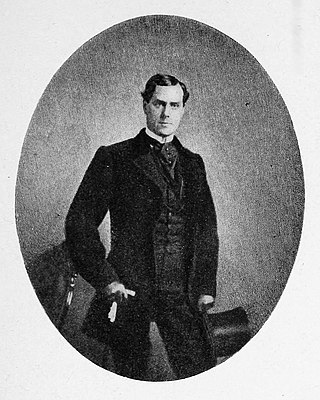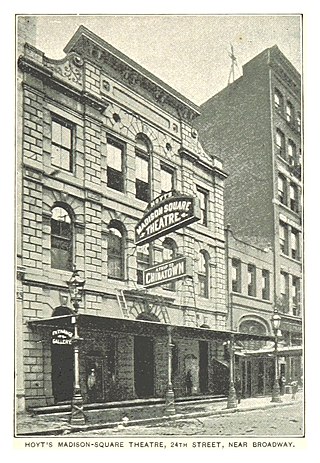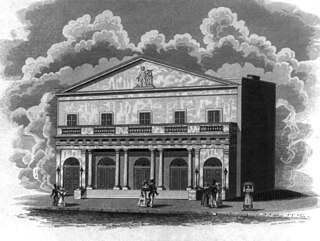
Lionel Barrymore was an American actor of stage, screen and radio as well as a film director. He won an Academy Award for Best Actor for his performance in A Free Soul (1931), and is known to modern audiences for the role of villainous Mr. Potter in Frank Capra's 1946 film It's a Wonderful Life.

John Barrymore was an American actor on stage, screen and radio. A member of the Drew and Barrymore theatrical families, he initially tried to avoid the stage, and briefly attempted a career as an artist, but appeared on stage together with his father Maurice in 1900, and then his sister Ethel the following year. He began his career in 1903 and first gained attention as a stage actor in light comedy, then high drama, culminating in productions of Justice (1916), Richard III (1920) and Hamlet (1922); his portrayal of Hamlet led to him being called the "greatest living American tragedian".
The Barrymore family, and the related Drew family, form a British-American acting dynasty which traces its acting roots to the mid-19th century London stage. After migrating to the US, members of the family appeared in motion pictures.

John Augustin Daly was one of the most influential men in American theatre during his lifetime. Drama critic, theatre manager, playwright, and adapter, he became the first recognized stage director in America. He exercised a fierce and tyrannical control over all aspects of his productions. His rules of conduct for actors and actresses imposed heavy fines for late appearances and forgotten lines and earned him the title "the autocrat of the stage." He formed a permanent company in New York and opened Daly's Theatre in New York in 1879, and a second one in London in 1893.

Ethel Barrymore was an American actress and a member of the Barrymore family of actors. Barrymore was a stage, screen and radio actress whose career spanned six decades, and was regarded as "The First Lady of the American Theatre". She received four nominations for the Academy Award for Best Supporting Actress, winning for None but the Lonely Heart (1944).

John Drew was an Irish-American stage actor and theatre manager.

Helene Wallace Stoepel, known professionally as Bijou Heron, was an American stage actress, who became famous as a child actor in the 1870s.

Herbert Arthur Chamberlayne Blyth, known professionally by his stage name Maurice Barrymore, was an Indian-born British stage actor. He is the patriarch of the Barrymore acting family, and the father of John, Lionel and Ethel.

Louisa Lane Drew was an English-born American actress and theatre owner and an ancestor of the Barrymore acting family. Professionally, she was often known as Mrs. John Drew.

Blanche Roosevelt was an American opera singer, author and journalist. She is best remembered for creating the role of Mabel in The Pirates of Penzance by Gilbert and Sullivan when that opera premiered on Broadway in 1879.

Charles Fisher was an American stage actor and comedian. Born to a prolific theatrical family from Norfolk, England, Fisher went on to find success as an actor in different parts of England, and then from 1852 onwards in New York City where he worked as a highly regarded performer for almost 40 years in the companies of William E. Burton, Laura Keene, James William Walluck, and Augustin Daly.

Ada Rehan was an American actress and comedian who typified the "personality" style of acting in the nineteenth century.

Georgiana Emma Drew, a.k.a.Georgie Drew Barrymore, was an American stage actress and comedian and a member of the Barrymore acting family.

The Fifth Avenue Theatre was a Broadway theatre in Manhattan, New York City, United States, at 31 West 28th Street and Broadway. It was demolished in 1939.

Florence Reed was an American stage and film actress. She is remembered for several outstanding stage productions, including The Shanghai Gesture, The Lullaby, The Yellow Ticket and The Wanderer. Her best remembered movie role was as Miss Havisham in the 1934 production of Great Expectations. In this version, however, Miss Havisham was changed from a completely insane woman to an eccentric, who did not wear her wedding veil constantly, and who dies peacefully rather than as a result of suffering burns in a fire. In the 1950s, Reed performed in several early television shows, such as The Philco Television Playhouse, Kraft Television Theatre and The United States Steel Hour. She is a member of the American Theater Hall of Fame.

The Globe Theatre (est.1871) was a playhouse in Boston, Massachusetts, in the 19th century. It was located at 598 Washington Street, near the corner of Essex Street. Arthur Cheney oversaw the Globe until 1876. From 1871-1873 it occupied the former theatre of John H. Selwyn. After a fire in May 1873, the Globe re-opened on the same site in December 1874. Architect Benjamin F. Dwight designed the new building. From 1877-1893 John Stetson served as proprietor; some regarded him as "a theatrical producer with a reputation for illiteracy in his day such as Samuel Goldwyn has achieved" in the 1960s. The theatre burned down in January 1894.

The Madison Square Theatre was a Broadway theatre in Manhattan, on the south side of 24th Street between Sixth Avenue and Broadway. It was built in 1863, operated as a theater from 1865 to 1908, and demolished in 1908 to make way for an office building. The Madison Square Theatre was the scene of important developments in stage technology, theatre design, and theatrical tour management. For about half its history it had other names including the Fifth Avenue Theatre, Daly's Fifth Avenue Theatre, Hoyt's Madison Square Theatre, and Hoyt's Theatre.

The Arch Street Theatre in Philadelphia, Pennsylvania, during the 19th century, was one of the three main Philadelphia theaters for plays; the other two were the Walnut Street Theatre and the Chestnut Street Theatre. The Arch Street Theatre opened on 1 October 1828 under the management of William B. Wood. The building's architect was John Haviland.

Mount Vernon Cemetery is a historic rural cemetery located at 3499 West Lehigh Avenue in the East Falls neighborhood of Philadelphia, Pennsylvania. It was established in 1856, is 27 acres in size and contains over 18,000 graves. It was neglected for decades by an absentee landlord. No plots have been sold since 1968, it was not open to the public, many graves fell into disrepair and the cemetery became heavily overgrown. In 2021, a Philadelphia judge ordered the cemetery be placed in conservatorship due to neglect.

Arthur McKee Rankin (1841–1914) was a Canadian born American stage actor and manager. He was the son of a member of the Canadian Parliament. After a dispute with his father he left home to become an actor. He made his stage debut in Rochester, New York in 1861 using the name George Henley. In 1863 he was seen at Wood's Theatre in Cincinnati in the play The Stranger as The Count. During this time he was engaged by Mrs. John Drew at her Arch Street Theatre in Philadelphia. Rankin, a Canadian, had no role or participation in the American Civil War. In 1866 he appeared at the Olympic Theatre in London run by Mrs. John Wood. Rankin increasingly became popular in the melodramas of the period and in 1867 was in a play called The Hunchback. In 1870 he appeared with Lydia Thompson in Mosquito and was a leading man from 1873 to 1875 at the famous Union Square Theatre. Having married Elizabeth Blanchard better known as Kitty they acted together in the 1870s appearing in the smash hit play The Two Orphans in 1874.

















